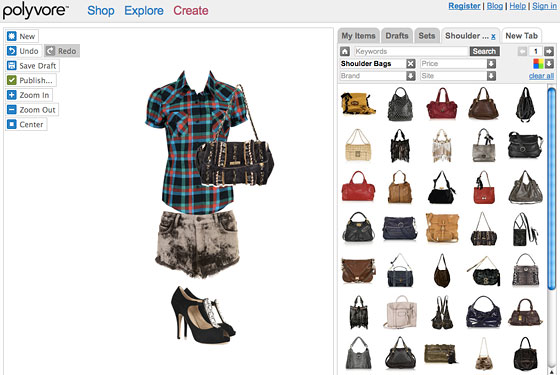Connecting Youth to Online Resources through Mentorship
April 26, 2013
PROJECTS: Leveling Up
PRINCIPLES: Interest-powered, Openly networked
TAGS: Fashion Camp
Those interested in learning more about fashion can look no further than YouTube for countless online guides and other resources. For example, thousands of YouTube videos provide instructions for fashion styling and make-up as well as how-to’s to learn sewing, sketching, and step-by-step guides to create various garments.
YouTube video that provides a step-by-step guide to design a high waisted skirt.
Some researchers, however, argue that new media users are subject to a phenomenon called attention scarcity due to information abundance1. Attention scarcity results in two related outcomes of importance to connected learning. On the one hand, online resources are incredibly numerous and offer seemingly unlimited potential for skill-building across a variety of subjects. On the other, the vast amount of information available may be a hindrance to identifying key materials most useful for tasks at hand. To address attention scarcity, participants at Fashion Camp, where I conduct my fieldwork, believe that online materials are most helpful to youth when they have other supports and mentors to guide them through online resources. Opportunities for skill-building need to be sharpened and guided by purpose and interests in order for it to be productive for learning.
For example, Jimmy2 is a 4th grader who has a passion for fashion and has attended many of the Fashion Camp courses on sketching, sewing, and design. While an avid technology user and video game player (his father noted that he picks up computers, iPads, and video games very quickly), he did not know how to integrate online media into his own design practices before receiving instruction at the camps:
“I didn’t really know that many websites before Fashion Camp, and Polyvore was one of them. I’ve just been looking up pictures of different fashion garments to get inspired to sketch new ones. I just sketch them to work on my drawing.”
Although Jimmy is a skilled technology user with great passion for fashion design, he did not know which websites to use to improve his skills. The Fashion Camp teachers recognized that students, like Jimmy, may not have been exposed to digital literacies around fashion, so they provided technical resources and integrated Polyvore, a fashion media platform. While the camps direct students to online resources, they also construct the websites in particular ways that render them useful for skill building. Fashion Camp teachers integrate Polyvore, an online social forum for fashion garments, into many of their design lessons. Anne, the camp owner and manager, teaches students how to use the website to refine their fashion skills:
“[With Polyvore] you create an inspiration board around an outfit, including mood and style. So for a styling class it gives them the ability to do that. I can’t take them to a store and say ‘style this look,’ but with Polyvore they can create an entire mood, the way, say maybe a magazine stylist would have to create a mood for a photo shoot.”
By itself, Polyvore stands as an interesting website that allows users to identify and purchase fashion garments. However, with Anne’s support and mentorship, the website is transformed into a tool for learning that students like Jimmy use both in the classroom and at home to refine their design skills. Anne believes that new media can be a great support for fashion design learning, but learning through these tools without mentors is difficult – “no matter how many YouTube videos you want to watch.”

Image of Polyvore’s “Create” mode, where users may assemble different garments and accessories to create an outfit.
Parents also provide their children with support so that they may best identify and take advantage of online resources for fashion design. Lily, a 4th grader, was trying to learn how to use a sewing machine at home after receiving lessons on sewing machines at the camp. However, their sewing machine at home was a different model than what Lily used at the camp. Her mother, Daria, explained that she and her daughter explored different media and search engines together to figure it out:
“We used the CD package, the manual online…and we put them on to learn the basics. And what we still couldn’t get we looked up on Google and YouTube. [On YouTube] people have instructions for the videos. I look through it and make sure it relates.”
Daria also believes that investigating online resources together with her daughter allows her to filter suitable content:
“She can’t go on the computer by herself. I have to because I have to make sure it’s kind of appropriate. You look something up and you never know what’s going to pop up.”
Parents, together with their children, can explore online resources together to identify useful and age-appropriate material for student learning. As with Lily and Daria, student and parent can focus their engagement with media on interests and expertise development while the child’s interest is driving the shared inquiry and evaluation of online resources. Fashion camp participants, including students, teachers, and parents, provide examples of how interest-driven learning can occur in an openly networked setting through strong intergenerational ties and mentorship. While youth may find useful online resources on their own given the opportunity, teachers and parents can be important guides for new media-supported learning.
(1) See Hargittai, E. 2000. “Open Portals and Closed Gates? Channeling Content on the World Wide Web.” Poetics 27(4):233-256 and DiMaggio, P., and Hargittai, E. 2004. “From unequal access to differentiated use: A literature review and agenda for research on digital inequality.” Pp. 355-400 in Social inequality, edited by K. Neckerman. New York: Russell Sage Foundation.
(2) All group and individual names have been changed to protect the identity of respondents.


